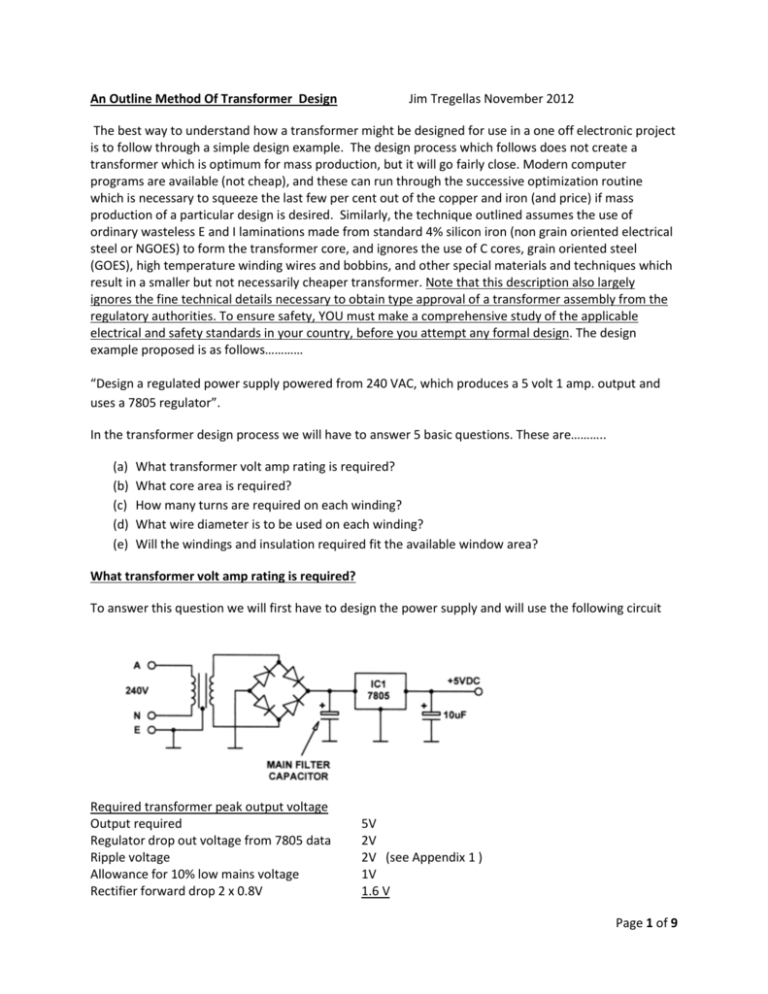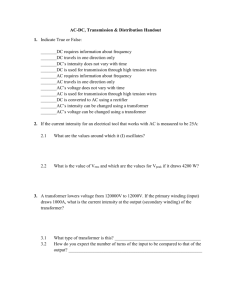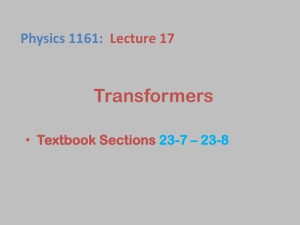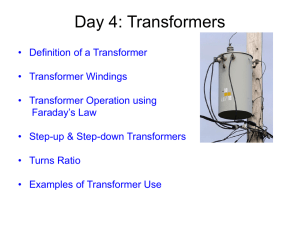a Shortform Method of Designing Power Transformers
advertisement

An Outline Method Of Transformer Design
Jim Tregellas November 2012
The best way to understand how a transformer might be designed for use in a one off electronic project
is to follow through a simple design example. The design process which follows does not create a
transformer which is optimum for mass production, but it will go fairly close. Modern computer
programs are available (not cheap), and these can run through the successive optimization routine
which is necessary to squeeze the last few per cent out of the copper and iron (and price) if mass
production of a particular design is desired. Similarly, the technique outlined assumes the use of
ordinary wasteless E and I laminations made from standard 4% silicon iron (non grain oriented electrical
steel or NGOES) to form the transformer core, and ignores the use of C cores, grain oriented steel
(GOES), high temperature winding wires and bobbins, and other special materials and techniques which
result in a smaller but not necessarily cheaper transformer. Note that this description also largely
ignores the fine technical details necessary to obtain type approval of a transformer assembly from the
regulatory authorities. To ensure safety, YOU must make a comprehensive study of the applicable
electrical and safety standards in your country, before you attempt any formal design. The design
example proposed is as follows…………
“Design a regulated power supply powered from 240 VAC, which produces a 5 volt 1 amp. output and
uses a 7805 regulator”.
In the transformer design process we will have to answer 5 basic questions. These are………..
(a)
(b)
(c)
(d)
(e)
What transformer volt amp rating is required?
What core area is required?
How many turns are required on each winding?
What wire diameter is to be used on each winding?
Will the windings and insulation required fit the available window area?
What transformer volt amp rating is required?
To answer this question we will first have to design the power supply and will use the following circuit
Required transformer peak output voltage
Output required
Regulator drop out voltage from 7805 data
Ripple voltage
Allowance for 10% low mains voltage
Rectifier forward drop 2 x 0.8V
5V
2V
2V (see Appendix 1 )
1V
1.6 V
Page 1 of 9
12.6V
The RMS secondary voltage is thus 0.707 x 12.6 = 8.91V say 9 volts RMS at full load.
and the VA rating is {12.6- (Vripple/2)} x 1 amp.= {12.6 – 1} x 1= 11.6VA
The transformer RMS secondary current is 11.6/9 = 1.3 amp
And the primary current is 11.6/240 = 48.3 mA
The filter capacitor required is
1 x10−2
2
= 5000uF (use 4700uF and see Appendix 1)
What Core Area is Required?
Having calculated the VA rating as 11.6VA, the core area is calculated from the empirical relationship
𝐴 = 116√𝑉𝐴 or 𝑉𝐴 = (𝐴/116)2
where A is the core cross sectional area in square mm
VA is the transformer VA rating
This empirical relationship is based on the amount of copper which can be jammed into the window of a
standard wasteless lamination (see Appendix 2). For simple transformers with only one primary and
secondary winding, this relationship is relatively accurate, and may actually underestimate the core
capacity by up to 10%. For complex transformers with many separate windings and much interwinding
insulation, it may overestimate the core capacity by up to 300%.
For our example 𝐴 = 116√11.6
=395 mm2 or roughly 20 x 20 mm for the centre leg.
Now a standard core and bobbin assembly are available with the above dimensions which we will use.
Core cross sectional area = 22 x 22 = 484 mm2
Page 2 of 9
Window area (each side) = 10 x 15 = 150 mm2
How many turns are required on each winding?
This is simply calculated from the universal transformer equation
𝑁=
108 𝐸
444𝑛𝑓𝐵𝐴
where
N is the number of turns
f is the frequency in Hz (normally 50Hz)
B is the core flux density in Tesla
A is the core cross sectional area in mm2
n is the core stacking factor
E is the rms winding voltage
A few words on a couple of terms in this equation –
Flux density B. As the transformer grows larger, its volume increases faster than its surface area, and so
to avoid overheating, the core flux density must be reduced to decrease core losses/ kilogram of iron.
For large transformers (above 300VA), the core flux density used should probably lie between 1.1 and
1.2 Tesla. For transformers from say 30-300VA use 1.15- 1.25 Tesla, and for units smaller than 30VA use
1.2-1.3 Tesla or even more if the unit is very small. Where leakage flux is important (hi fi amps,
electronic instruments) use 0.8 – 1.0 Tesla to stay in the linear portion of the BH curve. The object of the
exercise is to make the core and copper losses about equal for maximum efficiency, but this is not
always possible. Grain oriented cores can be run at slightly higher flux densities.
Core stacking factor n This actually describes what part of the core is solid iron (as opposed to the oxide
on each lamination which is placed there to reduce eddy current losses). For most common laminations,
this figure is about 0.95 (95%).
For our example the turns per volt are
108
444 𝑥 0.95 𝑥 50 𝑥 1.2 𝑥 484
= 8.164 T/V
For the 240 volt primary there are thus 8.164 x 240 = 1959 turns
Obviously there will be resistive losses in the transformer which cause the secondary output voltage to
drop from its no load figure when under full load. To compensate for this drop we must multiply the
secondary voltage by a fiddle factor, and the following are typical.
30VA
100VA
300VA
1.10 ( known as 10% voltage regulation)
1.06
1.02
The no load secondary voltage required is thus 1.1 x 8.91 = 9.8V RMS
and the secondary turns are therefore 9.8 x 8.164 = 80 turns
These figures can be much refined if one is prepared to go to the extra trouble of calculating the mean
length/turn and multiplying by the number of turns to get a total winding length for both primary and
secondary. The resistance of each winding can then be calculated using data from the wire tables, and
after referring the secondary resistance back to the primary (or vice versa), an accurate figure for
regulation can be obtained and the secondary turns corrected appropriately.
Page 3 of 9
What Wire Size?
The size of wire used governs the temperature rise which occurs in the finished transformer due to the
resistive losses in the wire. The following current densities give temperature rises of <40C above
ambient temperature and are a good starting point.
For < 30VA transformers
For 30- 150VA
For >150VA
3.4 amps/mm2 or 2200 amps/inch2
2.8 amps/mm2 or 1800 amps/inch2
2.3 amps/mm2 or 1500 amps/inch2
Obviously to minimize heating and improve regulation, the largest wire size possible should be used and
in all cases the objective is to fill the bobbin space available. The figures just given therefore only dictate
the minimum wire size that should be used.
In our example the primary current was 48.3mA, and secondary current was 1.3 amp.
For the primary we will therefore need a cross sectional area of
Thus 𝜋𝑟 2 =
0.0483
3.4
0.0483
3.4
square mm of copper.
and the wire radius comes out at 0.0672 mm, or 0.134 mm diameter.
Doing the same sum for the secondary current of 1.3 amps produces a wire diameter of 0.77mm.
The nearest wire sizes for the primary are 0.16, 0.18, and 0.20 mm. For the secondary, the nearest sizes
are 0.8, 0.85, and 0.9 mm. We will try the 0.2 mm and 0.9mm wires to see if they fit the available
window areas in the bobbin.
Will the wire and insulation fit the bobbin?
To answer this question we need four pieces of data.
(a) The wire diameter
(b) The number of turns
(c) The method of winding
(d) The window area
The method of winding used for most transformers is scramble winding (as opposed to layered winding
where each layer of wire is separated by a layer of insulation).
To calculate the window area needed, we add 0.02mm to the wire diameter (to account for the
thickness of a single layer of enamel insulation), square this number (because a circular wire occupies a
square shape in the winding cross section), multiply this figure by 1.2 (to account for included air spaces
in the winding) and then multiply by the number of turns.
So for the primary:
Area = (0.222) x 1959 x 1.2 = 113.79 mm2
We can use the heavy wire with room to spare as the available window area is 150 mm2
and for the secondary:
Area = (0.922) x 80 x 1.2 = 81.25 mm2
Again the heavier wire fits.
The finished design is thus
Primary 240V 1959 turns of 0.2mm diameter copper
Page 4 of 9
Secondary 9V 80 turns of 0.9mm diameter copper
Note that the use of much heavier wire than actually required significantly boosts the amount of power
this assembly can handle. It is thus not surprising that this particular core forms the basis for winding a
very popular transformer which features a 15V RMS 1 amp multi-tap secondary winding (15VA rating).
Insulation
Providing safe insulation on a transformer is something of an art form. The comments and diagrams in
this section are simply suggestions as to how this desirable result may be achieved, and comprehensive
testing must be done on each transformer to ensure safety and electrical requirements are actually met.
However, here are a few observations which may make the path to the goal rather easier………
Winding wire
A large number of different insulating lacquers are used to coat winding wire, and winding wire is
generally supplied with single or double lacquer overcoats. From a transformer design point of view,
three properties of winding wire are of interest, these being the maximum safe operating temperature
(developed in the hot spot in the centre of a winding), the breakdown voltage of the insulating lacquer
film, and the number of pinhole defects which may occur in the film.
The film breakdown voltage is a complex function of wire diameter, and increases as the wire diameter
increases, but even for the smallest singly coated wires 0.03mm diameter, the breakdown voltage is a
minimum of 200 volts. So for 2 wires in contact, ignoring pinholes in the film, this figure becomes 400
volts. Taking pinholes into account and possible abuse to the film during winding, a safe working figure
in a scramble wound winding is thus about 100 volts per layer. Note that in a high voltage scramble
wound winding, the thickness of the winding should be built up evenly to prevent the possibility of turns
near the start and end from lying next to one another, causing winding breakdown. In a very high
voltage winding it is probably sensible to break it down into 200 volt sections, each comprehensively
insulated from the next section with high quality electrical tape.
The problem of excessive hot spot temperature rise should not arise if the quite conservative current
densities cited earlier in this article are used. This is true even if low temperature wire insulation such as
polyurethane is used. This self fluxing wire is great, allowing the winding ends to be easily tinned by
dipping them into a solder pot. No stripping is required, and the wire is safe for use at winding
temperatures up to 120C. Usually this sort of insulation has the colour of raspberry jam and is marketed
under names such as Solderite. However, if temperature rise is of concern, it can be measured by using
the change in resistance method detailed in the literature.
Insulation materials
Air is by far the worst insulator likely to be encountered, with a breakdown voltage of about 30KV/cm or
75KV/inch. As transformer tests normally involve applying at least 3KV RMS between windings, and
between each winding and core, the minimum air gap existing between a bare uninsulated winding or
termination and anything else metallic should be at least 1.5mm, with 3mm being desirable.
No low melting point plastic should ever be used (eg polyester) in a transformer because under
mechanical stress, these plastics flow, eventually leaving no insulation at all. Australian standards
demand that if unfilled nylon or similar bobbins are used, two C shaped pieces of elephant hide must be
placed on the central partition of the bobbin, in case the transformer should become overhot under
gross overload. This prevents the primary and secondary windings coming into contact if the bobbin
melts. Glass filled bobbins are infinitely superior in this regard and not much more costly.
Page 5 of 9
Page 6 of 9
Appendix 1- Selecting the Main Filter Capacitor in a DC Power Supply
These days, dc power supplies most commonly use a capacitive filter to smooth their output voltage,
with choke input and pi section filters now being rarely used. If the capacitor discharge is assumed to be
constant current, then the following simple equations for capacitors can be used.
q = It
and q=CV and hence CV =It OR
C= It/V where V is the ripple voltage required
I is the supply dc output current
T is the discharge time
To calculate the capacitor required, assume the discharge time is either the full 10 milliseconds of a half
cycle (full wave rectification) or 20 milliseconds (half wave rectification). Depending on the actual ripple
percentage chosen, this assumption will cause the capacitor value to be around 10 – 20% bigger than
required, which is no bad thing as electrolytic capacitors normally have wide offset tolerances.
Capacitors are typically manufactured with a -10% +50% tolerance on their value.
The ripple percentage chosen ( 100 Vripple/ Vpeak) should lie between 5 and 25%, with 10% being a
good design compromise. Using ripple percentages of less than 5% is rarely done and generally is poor
design practice because all of the energy supplied to the power supply load during the capacitor
discharge time, has to be delivered in a very short pulse at the peak of the half cycle. This creates huge
peak currents which in turn badly stress the transformer, rectifiers, and storage capacitor, creating
considerable amounts of heating.
Page 7 of 9
Appendix 2- Wasteless Laminations
Most mass produced transformers being manufactured these days use wasteless laminations to form
their magnetic core. There is no waste because two “I” laminations are stamped from the windows of
two “E” laminations, completely using all the metal in the strip from which they are punched. This
production method results in a pair of laminations of fixed proportions.
Working across the width of the E lamination in the second diagram, these proportions are
Left and right hand leg, both windows, and bottom of the E
1 unit
Centre leg
2 units
Because of these relationships, the “I” lamination ends up being 6 units long and 1 unit wide. This in turn
forces the “E” to be 4 units high and have 2 windows 3 x 1 unit. The assembled transformer thus ends up
with proportions of 5 units high and 6 units wide.
Knowledge of these relationships is very handy when designing a transformer, but even more useful if a
transformer is to be rewound. The cross sectional area of the core has to be known in order to
determine the turns/volt which will be used, but the width of the centre leg usually cannot be measured
accurately because it is buried under the bobbin and/or a whole lot of insulation/wire. Fortunately, all
that is necessary to obtain the width of the centre leg is to measure the total width of the “E” and then
divide by 3. This figure is then multiplied by the thickness of the lamination stack to get the core cross
sectional area.
Page 8 of 9
Core Area
Inch2
0.5
0.75
1.0
1.25
1.5
2.0
mm2
323
484
645
806
968
1290
Power Rating
watts
8
18
31
49
70
125
Core Area
inch2
2.5
3.0
3.5
4.0
5.0
6.0
mm2
1613
1935
2258
2581
3226
3871
Power Rating
watts
195
280
381
500
780
1120
Page 9 of 9






